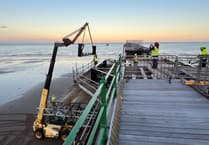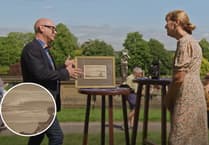The operation to move eleven 1,000-year-old Viking and Celtic crosses was always going to be fraught with difficulty.
But no one could have envisaged quite how challenging it was going to be.
A number of the Manx crosses dating from the 7th to 11th century displayed at Andreas church were moved without any issues.
These included the collection of wall-mounted early Celtic fragments.
And the two large standing cross slabs, Sandulf’s and Gaut’s crosses, were extracted with relative ease despite their bases being buried in concrete to a depth of 2ft.
But it was different matter entirely when it came to the five carved stones mounted on a concrete plinth constructed in the late 1950s.
It was discovered they had been set in cement described as 'weapon grade'.
Manx National Heritage's conservation manager Chris Weeks said: 'Most of them came out fine. They were either attached to the walls or they were standing in the floor.
‘And those were, despite their size, relatively easy to move.
‘But the remaining five are very, very difficult, because they've cast into a giant block of concrete, which is really very, very tough.
'We've had to change tactics and bring in some very heavy machinery to try and break it up.
'It's not what you would like to do with very old objects of this vintage and importance.’
.jpeg?width=752&height=500&crop=752:500)
With chisels and angle grinders found to be not up to the job, Andreas church volunteer Waveney Jenkins enlisted the help of contractors Island Drainage and Groundwork who have been carrying out roadworks in the village.
They brought in a micro digger fitted with a jack hammer to break up the concrete.
Church authorities and MNH had agreed the project, 10 years in the planning, to move the crosses to display them an improved, secure and more accessible way.
Waveney admitted: 'It’s been extremely fraught. They were not expecting to find weapon grade concrete. They are doing it incredibly carefully.’

The crosses are being moved to a better site at the NW corner of the nave, freeing up space for more communal activities.
There will be a state-of-the-art museum showcase for fragments of small cross slabs of particular value and interest once they are extracted from the concrete plinth.
These include Thorwald’s cross, which has been borrowed twice by the British Museum for important exhibitions on Viking history.
This was the first to be removed from the plinth as it had been set differently to the others, having previously been displayed in a wooden frame.
A showcase has been commissioned from Dellner Glass in UK with specially designed lighting to enable all the carved detailing to be clearly seen.
It will be brought across, with assistance from the Steam Packet's Manx Community Assistance Scheme, as soon as all the crosses have been released from the concrete and any remedial cleaning carried out.
Volunteers are looking to fund raise to cover the extra costs associated with relocation works. Donations from local businesses and individuals will gratefully received.




.jpg?width=209&height=140&crop=209:145,smart&quality=75)